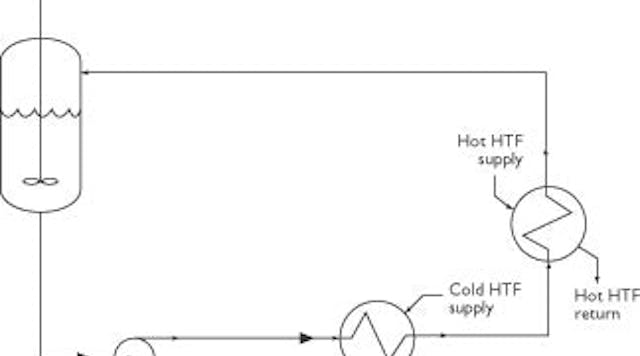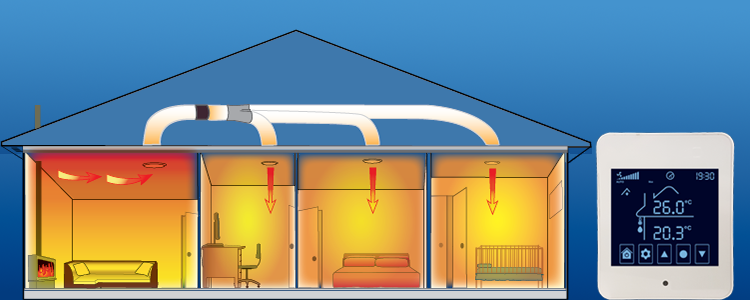The Role of Heat Transfer Equipments in Sustainable Power Solutions for the Future
Heat transfer systems are important in the quest for lasting energy services. They optimize thermal power administration, boosting the effectiveness of sustainable modern technologies. By utilizing mechanisms like convection, transmission, and radiation, these systems decrease energy losses. Their role in solar thermal and geothermal applications is specifically substantial. As technologies arise, the potential for more improvements increases essential concerns concerning future power strategies. What developments will form the landscape of sustainable power?
Comprehending Heat Transfer Solutions

The Importance of Thermal Power Management
Efficient thermal power administration is vital for optimizing power efficiency and reducing waste in different systems. By controling temperature level and enhancing Heat transfer procedures, organizations can considerably minimize energy usage and operational prices. Efficient management includes the execution of sophisticated technologies and practices that check and control thermal problems within systems, making certain that energy resources are used effectively. In enhancement, correct thermal energy administration contributes to reducing greenhouse gas exhausts, lining up with international sustainability objectives. It also boosts system dependability and efficiency, causing improved product quality and longer equipment lifespan. Eventually, focusing on thermal energy management is a crucial step towards developing more sustainable energy solutions and fostering a responsible technique to power usage in commercial and property contexts.
Applications of Heat Transfer in Renewable Energy
While various renewable energy resources assure sustainability, the effective application of Heat transfer plays a necessary duty in their effectiveness. In wind energy systems, Heat transfer is utilized for turbine component cooling, improving efficiency and long life. Geothermal energy relies upon effective Heat exchange in between the planet's subsurface and the fluid distributing in the system, taking full advantage of power extraction. Biomass energy procedures likewise take advantage of Heat transfer, as it aids in converting natural products into usable gas via pyrolysis and gasification. Additionally, in hydropower, preserving perfect temperatures in tanks can improve power outcome. Each of these applications demonstrates the crucial significance of Heat transfer systems in boosting renewable resource modern technologies, eventually adding to an extra sustainable power future.
Enhancing Solar Thermal Power Performance
As solar thermal power systems remain to evolve, enhancing their efficiency has come to be essential for making the most of energy outcome. Advances in Heat transfer modern technologies, such as improved thermal storage space materials and innovative Heat exchangers, play a significant duty in enhancing performance. By making use of sophisticated products that have remarkable thermal conductivity, systems can catch and move Heat better. Additionally, integrating monitoring systems that follow the sun's path warranties that enthusiasts receive suitable solar exposure throughout the day. Utilizing nanotechnology in solar absorbers can additionally boost power absorption prices. Additionally, including computerized control systems helps regulate temperature levels and take care of energy circulation efficiently, bring about lowered losses and enhanced total system efficiency. These enhancements lead the means for even more lasting solar thermal energy remedies in the future.
Geothermal Home Heating: A Sustainable Solution
Geothermal home heating provides a feasible alternative for sustainable power, offering substantial environmental benefits via lowered greenhouse gas discharges. Its performance and cost-effectiveness make it an eye-catching choice to typical furnace. Difficulties related to execution needs to be addressed to optimize its potential influence.
Environmental Advantages of Geothermal
Typical home heating methods contribute considerably to greenhouse gas exhausts, geothermal home heating offers a compelling alternative that minimizes environmental impact. By using the Planet's interior Heat, geothermal systems use a renewable resource resource, markedly minimizing dependence on fossil gas. This technique produces minimal carbon emissions, making it a cleaner alternative for residential and industrial heating. Additionally, geothermal systems promote energy effectiveness, as they call for much less power compared to traditional furnace. DVS Heat Transfer Systems. The application of geothermal power additionally helps in decreasing air pollution, enhancing neighborhood air quality and public health. As a sustainable remedy, geothermal home heating supports climate adjustment reduction initiatives, placing itself as a necessary component in the shift towards a greener future
Effectiveness and Cost-Effectiveness
Exactly how does geothermal home heating measure up in terms of efficiency and cost-effectiveness contrasted to traditional heater? Geothermal heating demonstrates superior effectiveness, usually accomplishing a coefficient of performance (COP) of 3 to 5, meaning it produces three to 5 devices of Heat for each unit of electricity consumed. This efficiency more info here converts right into lower operating costs, especially in regions with steady geothermal resources. First installment expenses can be higher than conventional systems; however, lasting cost savings on energy expenses and reduced maintenance costs can counter these ahead of time financial investments. In addition, many governments incentivize geothermal systems with rebates and tax obligation credits, boosting their cost-effectiveness. On the whole, geothermal heating emerges as a economically feasible and sustainable option to more conventional home heating services.
Application Obstacles and Solutions
Various obstacles can impede the widespread implementation of geothermal furnace, regardless of their clear benefits as a sustainable energy option. High initial setup prices frequently hinder homeowners and financiers, making funding a significant barrier. In addition, the geographical constraints of suitable geothermal sites limit ease of access in certain areas. Local guidelines and allowing processes can likewise make complex task development, causing hold-ups. Furthermore, public understanding and understanding of geothermal systems continue to be reduced, hindering approval. To address these obstacles, targeted education projects can improve public expertise, while federal government motivations might ease monetary concerns. Working together with neighborhood authorities to streamline guidelines may promote smoother project authorizations, eventually advertising the adoption of geothermal heating as a viable, lasting energy choice.
Advancements in Heat Transfer Technologies
Developments in Heat transfer innovations play an important role in improving power efficiency and sustainability. Advanced Heat exchangers and phase change materials are at the forefront of these developments, offering substantial renovations in thermal administration. These innovations not only maximize power use yet likewise add to reducing environmental influence in different applications.
Advanced Heat Exchangers
Advanced Heat exchangers play a crucial role in improving energy effectiveness throughout different applications in lasting power services. These devices facilitate the transfer of Heat between 2 or even more fluids, noticeably decreasing power intake in processes such as industrial home heating, air conditioning, and power generation. Developments in products and layout, such as making use of nanofluids and portable setups, have led to boosted thermal performance and lowered dimension requirements. In addition, advancements in electronic surveillance and control systems enable for maximized procedure, further enhancing efficiency. By lessening waste Heat and optimizing power healing, progressed Heat exchangers add to decrease carbon footprints and support the change towards eco-friendly modern technologies. Their proceeded development is important for achieving global energy sustainability goals.
Phase Change Products
The integration of phase change products (PCMs) right into Heat transfer innovations represents a substantial improvement in energy management and effectiveness. PCMs soak up and launch thermal power throughout their phase changes, allowing reliable temperature level policy in building materials and energy systems. By saving excess Heat throughout height periods and launching it when demand rises, PCMs add to pack moving and power conservation - DVS Heat Transfer Systems. This ability boosts the efficiency of renewable resource systems, specifically in solar thermal applications. In addition, PCMs can improve the thermal comfort of indoor atmospheres, lowering reliance on conventional home heating and cooling down techniques. As technologies in PCM solutions proceed to arise, their duty in lasting power options is positioned to grow, providing promising opportunities for future research and application

Future Potential Customers for Heat Transfer in Lasting Energy
As the demand for lasting power remedies continues to rise, the function of Heat transfer systems is coming to be increasingly vital in shaping future innovations. Technologies in layouts and materials are expected to enhance efficiency in Heat transfer, lowering energy losses in different applications. The combination of innovative thermal storage systems, such as stage modification materials Extra resources and thermochemical storage space, will allow much better administration of power resources. Research right into nanofluids and biomimetic Heat exchangers may even more enhance thermal efficiency. Moreover, the fostering of clever modern technologies will certainly permit for real-time surveillance and flexible control of Heat transfer procedures. These developments are poised to significantly contribute to the general effectiveness and sustainability of power systems, leading the means for a more energy-efficient future.
Regularly Asked Inquiries
Just How Can People Carry Out Heat Transfer Systems in your home?

Individuals can execute Heat transfer systems in the house by mounting energy-efficient home appliances, using radiant heating, and optimizing insulation. These measures boost power effectiveness, reduce prices, and advertise lasting methods in property environments.

What Are the Costs Related To Mounting Heat Transfer Systems?
The costs connected with setting up Heat transfer systems vary commonly, normally incorporating tools, installment labor, and upkeep. Variables such as system kind, home size, and neighborhood guidelines greatly affect the general expenditure involved.
Are There Federal Government Incentives for Heat Transfer System Installations?
Federal government rewards for Heat transfer system installations vary by area and can consist of tax debts, refunds, and gives. These financial advantages intend to motivate adoption, inevitably promoting power performance and decreasing environmental influence within communities.
Exactly How Do Heat Transfer Solutions Influence Energy Expenses?
Heat transfer systems significantly affect energy bills by maximizing energy performance. By boosting the transfer of Heat, these systems reduce power usage, causing reduced utility costs and developing an extra sustainable technique to power administration.
What Maintenance Is Needed for Heat Transfer Systems?
Upkeep for Heat transfer systems includes routine assessments, cleansing of components, inspecting liquid levels, making sure proper insulation, and changing worn parts. These jobs assist maintain efficiency, stop breakdowns, and lengthen the system's functional life-span.
These systems promote the motion of thermal power from one medium to an additional, allowing the transfer of Heat for air conditioning, power, or home heating generation purposes. Geothermal power click this site relies on reliable Heat exchange between the planet's subsurface and the fluid flowing in the system, making the most of power removal. Additionally, geothermal systems advertise energy effectiveness, as they require much less power contrasted to conventional heating systems. Advanced Heat exchangers play a crucial duty in enhancing energy efficiency throughout various applications in sustainable power remedies. Heat transfer systems notably affect power expenses by optimizing power effectiveness.